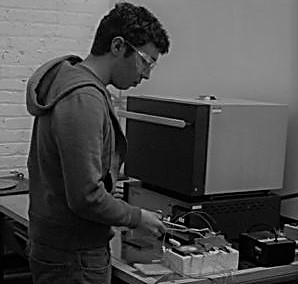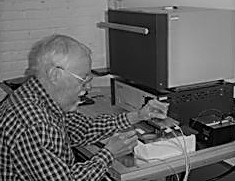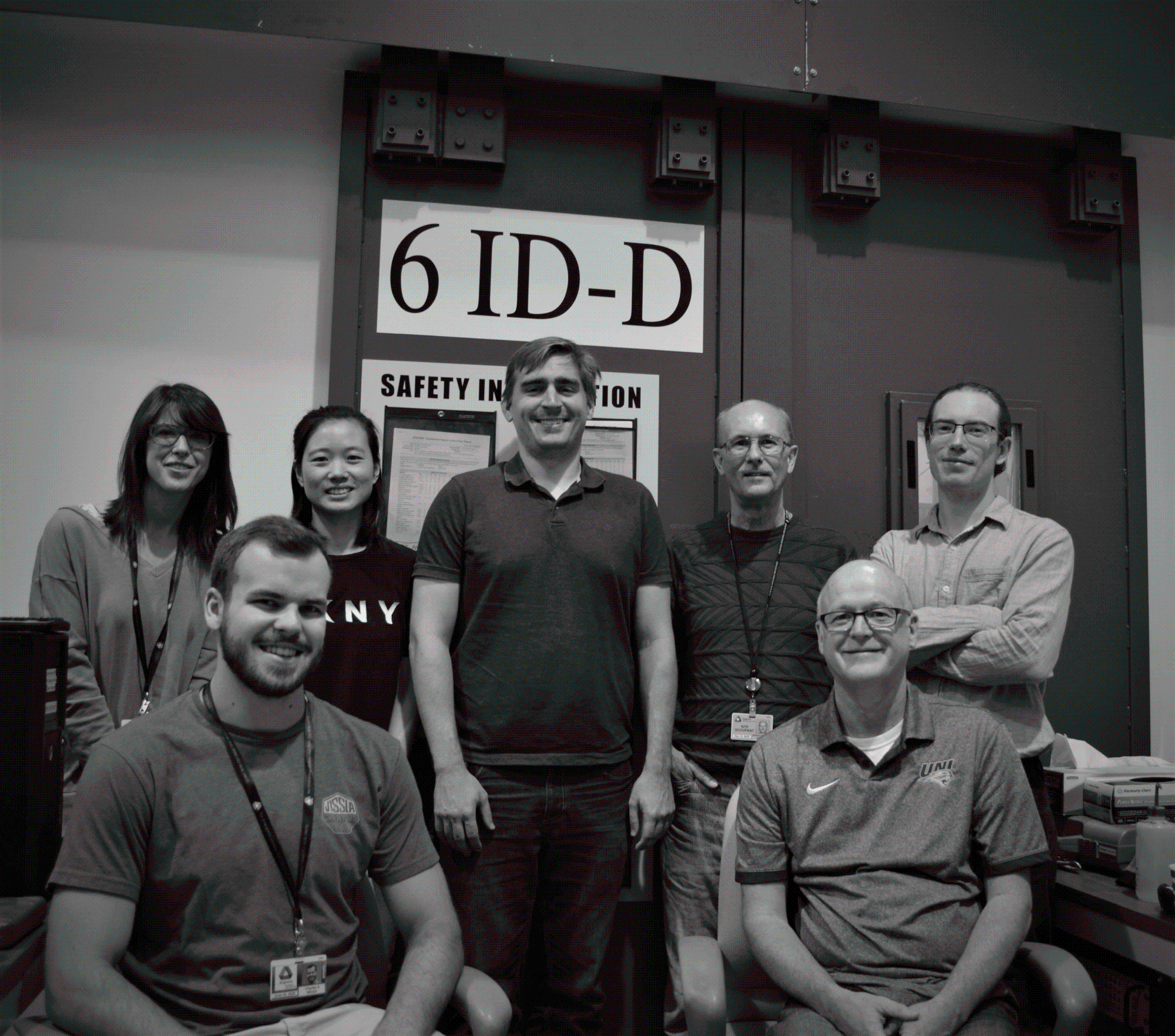
Heat treated glass test plate developed by MDI. This device demonstrates that high-resolution images can be made using nanophase storage phosphors.
Andrew Pottebaum processing glass x-ray image plates.


Sonia Tumber and Amit Tailor making glass samples in a glove box.

MDI Team at Argonne National Lab, December, 2013. L- R: Lawrie Skinner, Rick Weber, Anthony Tamalonis, Chris Benmore (APS), and Ollie Alderman.
Charlie Rey working on furnace electronics.

2023 - 2024
2017 - 2021
MDI started several new projects. Development of amorphous pharmaceuticals in collaboration with Argonne National Laboratory and Purdue University. Development of a hybrid aero-acoustic levitator for specialized work on materials including potential for in-situ thermophysical property measurements. Our experiments on International Space Station continued and are being run in 2022 as well. As for everyone, 2020 was a difficult year - we worked off site exclusively for about 12 weeks and returned in shifts in summer of 2020.
2016 - 2017
MDI and Argonne National Lab were invited to Adler After Dark at the Adler Planetarium where we showcased our Single-Axis Acoustic Levitator as part of Back to the Future night. We had a great time demonstrating our tech to the public and explaining the underlying science to all who were interested. MDI was invited out to Los Angeles to film two videos over the summer. With Destin Sandlin of Smarter Every Day on YouTube, we explained how acoustic levitation works and captured some amazing high speed footage using two Phantom cameras. Destin was so great to work with and the footage is spectacular; it's linked on our homepage if you missed it. At the same time, we filmed a bit for American Idol Season 14. In a short segment sponsored by Ford, the singers met with Destin, learned some science, and got to experiment with MDI's Single-Axis Acoustic Levitator themselves!

MDI's team after a successful beamline campaign at APS. L-R: Emma Clark, Charlie Weiss (Northwestern U.) Caijun Shi (APS) Anthony Tamalonis, Rick Weber, Chris Benmore (APS) and Ollie Alderman.
MDI History
2015
MDI continued basic and applied instrument development research to develop instruments for materials processing in extreme conditions. Recent accomplishments include implementation of XANES (X-ray Absorption Near-Edge Structure) and high energy x-ray diffraction measurements at the Advanced Photon Source to investigate iron oxidation state in molten geological materials. MDI staff presented papers at conferences, including ACerS GOMD-DGG 2015, PNCS XIV, and the SGT Annual Conference.
2014
MDI scientists, in collaboration with Argonne National Laboratory and Stony Brook University, published the results of structure measurements on glasses and liquids in Physical Review B and Science, respectively. These findings came from recent experiments utilizing MDI's unique HT-CNL system through MDI's continued mission to support research on extreme condition materials. This work is being done at both the Advanced Photon Source at Argonne National Laboratory and the Spallation Neutron Source at Oak Ridge National Laboratory. MDI also delivered and installed two SAL instruments to commercial clients in Japan and the UK.
2013
MDI completed successful beamline campaigns at the Advanced Photon Source at Argonne National Lab in Illinois and the Spallation Neutron Source at Oak Ridge National Lab in Tennessee to study various glasses and liquids.
2012
MDI installed HT-CNL systems in the Department of Physics at Coe College in Cedar Rapids, IA and also at Oak Ridge National Laboratory's Spallation Neutron Source in Oak Ridge, TN. Both instruments are being used for research on liquids and glasses. The instrument at Oak Ridge will also be used for work on glasses and liquids. The planned new structure measurement capability complements an existing system at the Advanced Photon Source, Argonne National Laboratory.
2011
MDI completed a Phase I SBIR project by the National Institutes of Health and worked on a Phase II project to commercialize our image plate technology. The objective of the project was to produce and scale up optical quality fluoride glass plate materials. The glasses can be doped with optically active ions and heat treated to form materials that can store X-ray images. The process exploits a photostimulable luminescent (PSL) effect in the glasses. After exposure to X-rays, the plate can be read using a laser device. Compared to other methods, the new technology provides high resolution and lower X-ray dosages for patients in procedures such as mammography. In addition, the use of glass plates offers cost advantages over competing digital techniques. MDIs experience in glass development is used to optimize glass processing and properties to make image plates up to 24 x 30 cm in size. The project complemented collaborations with researchers at the University of Tennessee, Stony Brook University, the University of Chicago and the University of Paderborn.
2008 - 2010
MDI's HT-CNL at Argonne National Laboratory's Advanced Photon Source was used to investigate the structure of undercooled melts that can undergo liquid-liquid phase transitions. The research was part of an international collaboration between scientists based in the UK, France, and the USA. The work is published in the journal Science (Vol. 322, pp. 566-570, 2008 and This Week in Science Vol. 322, pp. 501, 2008). A related News and Views article appears in Nature Materials (Vol. 7, pp. 843-844, 2008).


